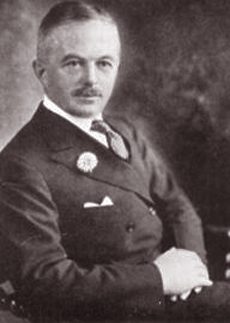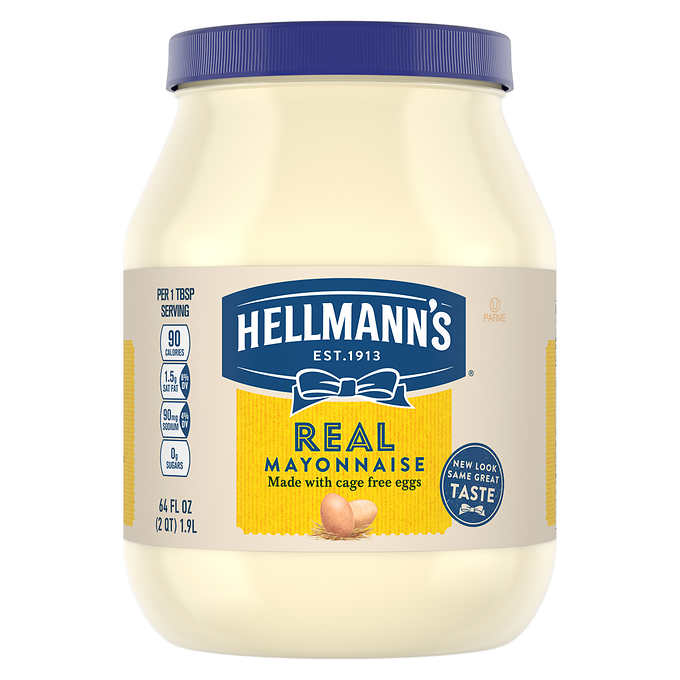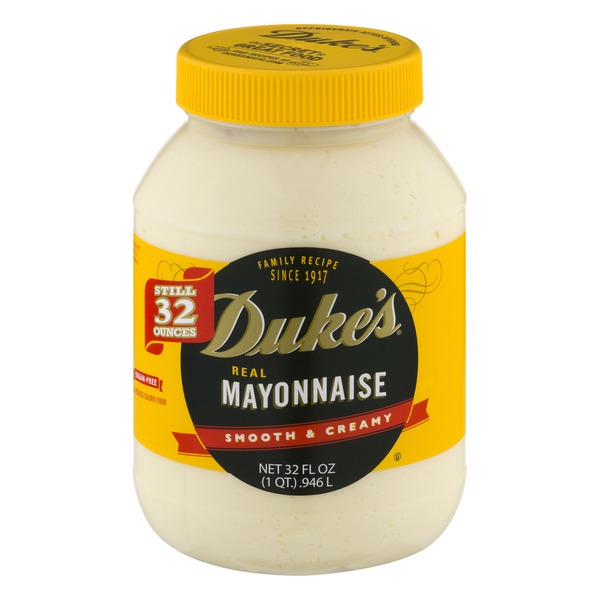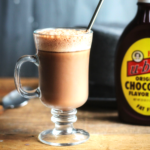America’s Favorite Condiment

One of my all-time favorites is a tuna salad sandwich--canned Albacore tuna packed in water with minced celery and onion, hard-boiled egg, a touch of garlic, and lots of America's favorite condiment, mayonnaise. And though some of you may dislike, even hate mayo, I'm among the majority who wouldn't think of having a ham and cheese or BLT sandwich without a nice slathering of this creamy, slightly tangy emulsified white sauce. Or a mayonnaise and tomato sandwich, with or without the tomato (I grew up on these, especially the latter).
"My favorite sandwich is peanut butter, baloney, cheddar cheese, lettuce, and mayonnaise on toasted bread with catsup on the side." - Hubert H. Humphry
But sandwiches are just the tip of the iceberg when it comes to the many ways we Americans enjoy this delicious and versatile condiment, either homemade or store-bought. There's potato salads, egg salads, chicken and macaroni salads. Mayonnaise is incorporated in a number of baked goods, as well as in fish and chicken entrees, deviled eggs, lobster rolls, and the list goes on and on. Mayonnaise is even used for cleaning, removing stains, conditioning hair, and much, much more.
Although mayo's popularity took a 3.3% decline last year, Americans still bought over $2 billion worth of the stuff last year, allowing it to continue its clear lead over the number two condiment, ketchup.
There are those who place the invention of mayonnaise squarely with the French while others give the nod to Spain. To my thinking, both countries actually played a part in its creation, and should therefore share the credit.
The first naval battle of the Seven Years War occurred between the French, commanded by Duke de Richelieu, and the British, led by Vice-Admiral John Byng, over Port Mahon on the southern end of Minorca, a small island that is part of Spain. It seems that after a week of intense fighting the French emerged victorious. Legend has it that while preparing the victory celebration feast, Richelieu's chef was unable to find the cream he needed to prepare the sauce for one of his main dishes. In true professional chef fashion, he decided creativity was the order of the day and substituted a concoction shown to him by local residents. He called this new sauce "mahonnaise," after its birth place.
However, mahonnaise didn't catch on until the 18th century when French chef Marie-Antoine Carême, founder of Haute cuisine, lightened the original recipe and popularized it to the world. Carême even renamed his innovation, calling it "mayonnaise." By the early 19th century just about every cookbook in Europe that featured French cuisine included the recipe for mayonnaise. And by mid-century word of this exciting new sauce had reached America.
At first mayonnaise was strictly homemade due to its short shelf life and tendency to separate. Even delicatessens only produced enough of the stuff for that day's business, including the small amount they sold to only their best customers.
Schlorer Deli
In 1907 there was a Philadelphia delicatessen owner named Edward Schlorer whose wife Amelia prepared the mayo used in their store. As more and more of their customers began requesting to purchase her wonderful mayonnaise, Schlorer decided to capitalize on the situation. Adding preservatives to his wife's recipe, he began making large batches in the  back room of their store and packing it in glass canning jars for sale to the public. In 1911 Edward trademarked the name Mrs. Schlorer's, making it not only America's first commercially produced mayonnaise, but the first to offer it in glass jars.
back room of their store and packing it in glass canning jars for sale to the public. In 1911 Edward trademarked the name Mrs. Schlorer's, making it not only America's first commercially produced mayonnaise, but the first to offer it in glass jars.
In 1980, Mrs. Schlorer's brand name was sold to Golden Barrel Products, a subsidiary of Good Food, Inc., and a division of Zook Molasses Company in Honey Brook, Pennsylvania. Since then, production of Mrs. Schlorer's Mayonnaise has been discontinued.
Enter Hellmann's
In October 1903, Richard Hellmann, a German immigrant with food experience, arrived in New York on his way to San Francisco. During his layover, Hellmann was offered a job with Francis H. Leggett Co. which he  quickly accepted. In August of the following year Hellmann married Margaret Vossberg, daughter of a couple he had known in Germany who came to America several years earlier.
quickly accepted. In August of the following year Hellmann married Margaret Vossberg, daughter of a couple he had known in Germany who came to America several years earlier.
In the summer of 1905, 29-year-old Richard and wife Margaret rented a storefront with an apartment in back and opened Hellmann's Delicatessen in the front. There the couple set out to make a name for themselves and begin a family. Like other deli owners of the time, Richard would make daily batches of his mayonnaise, using what they needed for the store, packing the rest in wooden boats to sell to their customers. Business was good for the Hellmann's and soon they purchased the building in which the deli was located, as well as the building next door.
In 1911, Hellmann suffered some health issues, forcing him to sell most of his delicatessen business to Charles Eberhardt, retaining a small interest for himself and his family. Later that year Richard, with his wife and young daughter, traveled back to Europe for the holidays. While there, he met with a former colleague who was president of his family's food business, which among other products they sold 5-pound wooden butter boxes of mayonnaise to hotels and other commercial entities. The idea piqued Hellmann's interest.
The Hellmann's trip was interrupted only weeks into their vacation by news that Eberhardt had suddenly died and they needed to return to New York to look after the delicatessen. By April 1912 Richard and his family were back. Soon after they got their deli running again, a wealthy customer requested the Hellmanns supply a large amount of mayonnaise for a big party he was having. The successful execution of that request renewed Richard's interest in the bulk mayonnaise business. Richard began testing the local market but with only lackluster results.

However, the growing popularity of his mayonnaise with his deli customers led him to the decision to concentrate on marketing his product directly to the consumer. On September 1, 1912, packaged in 3½ and 8½ ounce screw-top, wide-mouth reusable jars with three blue ribbons (later changed to only one) on the label, Hellmann sold out of his entire first day's production before it even hit the store shelves.
By the end of 1915, Hellmann's mayonnaise business was so successful that he sold the deli and opened a small factory on what today is West 126th street in Manhattan. By the end of the following year, continued growth required the company to move to a larger facility in Long Island City, New York, and the company was incorporated as Richard Hellman, Inc. Then in 1919, with no slow down of sales in sight, Richard also licensed John Behrmann in Chicago to make his mayonnaise. By the year 1927, Hellmann's Mayonnaise was selling $15 million a year and earning a $1 million profit.
In August 1927, Hellmann sold his company to Postum (which became Best Foods) who already enjoyed a thriving mayonnaise business on the West Coast as Best Foods Mayonnaise. Due to the popularity of both brands (together they control 45% of the U.S. market) Postum decided to keep both, marketing Best Foods Mayonnaise to states west of the Rocky Mountains and Hellmann's to states east of the Rockies. And though Best Foods was acquired by Unilever in the year 2000, it remains that way today.
Duke's
Duke's Mayonnaise got its start in 1917 when Mrs. Eugenia Duke began selling sandwiches made with her homemade mayonnaise to soldiers training at Camp Sevier in Greenville, South Carolina. As word spread, Greenville locals began asking for her sandwiches and soon Eugenia began selling them  at local drugstores. Soon she converted the first floor of Greenville's Ottaray Hotel into Duke's Tea Room, serving her famous sandwiches and a number of side dishes.
at local drugstores. Soon she converted the first floor of Greenville's Ottaray Hotel into Duke's Tea Room, serving her famous sandwiches and a number of side dishes.
By the early 1920s Eugenia's business had grown so big that she was unable to keep up with the sandwich orders from the small kitchen in her home, making it necessary to build a larger one. And although Eugenia's sandwiches were obviously delicious, it was her salesman C. B. Boyd who discovered the reason for their popularity was actually her tangy mayonnaise that made them so distinctively different. So Boyd urged Eugenia to start bottling and marketing her mayonnaise separately, which she did. Just as Boyd had predicted, Duke's Mayonnaise became a hit and Eugenia sold her sandwich operation to concentrate her efforts on producing the ever- increasing demand for her mayonnaise.

In 1929, Eugenia sold her mayonnaise business to C. F. Sauer Company, one of the nation's top spice producers, who began marketing and distributing Duke's Mayonnaise across the United States. Eugenia had agreed to serve as the mayonnaise spokeswoman for Sauer, but eventually left and moved to California to be close to her daughter. True to her entrepreneurial nature, while in California Eugenia opened the Duchess Sandwich Company selling sandwiches to drugstores and cafes.
Over the years, Duke's, America's third most popular mayonnaise after Hellmann's and Kraft, is responsible for a number of industry firsts. In 2003 Duke's was the first to introduce the squeeze bottle and in 2006 the first to adopt a plastic jar. In 2009, when numerous major mayonnaise brands downsized from the traditional 32-ounce jar to a 30-ounce jar, Duke's refused and stayed with a full 32 ounces.
Other innovations include introducing a light mayonnaise made with olive oil in 2012 and in 2015, a squeezable 1-cup pouch that is perfect for a picnic, cookout, or for use in 1-cup recipes.
While at first its sales were primarily limited to the South, today Duke's is available throughout the United States, as well as New Zealand, Australia, the Middle East, and Latin America. Duke's remains the flagship of C. F. Sauer Company in Richmond, Virginia.
Kraft
A late comer to the world of mayonnaise, in 1926 Kraft decided the best and fastest way to enter the market was to purchase four regional producers and put their name on the best recipe. Eventually they did well, that is until the Depression hit in 1930, and a lot of money-strapped homemakers went back to making their own mayo.

Kraft's answer to the situation was to produce a similar but cheaper product to sell until the Depression ended and mayonnaise sales bounced back. Enter Miracle Whip. While it looked like mayonnaise, tasted like mayonnaise, and could be used like mayonnaise, it did not meet the strict USDA criteria for mayonnaise. Therefore Kraft introduced Miracle Whip in New England in June 1933 labeling it "salad dressing."
Miracle Whip was so well received by the consumer that in only eight weeks of launching the product, Kraft took it national. And within six months Miracle Whip was outselling all other brands of salad dressing and  mayonnaise. By the 1950s Miracle Whip owned 60% of the salad dressing market.
mayonnaise. By the 1950s Miracle Whip owned 60% of the salad dressing market.
It would be 1988 before Kraft put any meaningful marketing emphasis on its mayonnaise. Since then, Kraft has launched a number of mayonnaise flavors included light and fat free versions, olive oil mayo, and a thicker, richer Homestyle Mayonnaise.
Best Tasting
After reading the results of several mayonnaise "blind" taste tests, it's very clear to me that this is one subject that should really be avoided. Most people tend to favor the brand they grew up eating, which is likely the major seller in the area where they live. But one note worth sharing is that the mayonnaise with the largest market share is not necessarily what test results show to be the consumers' preferred taste. So with that in mind, I will just list alphabetically the top eight mayonnaises based on all tests reviewed: Blue Plate, Duke's, Hellmann's/Best Foods, Kewpie, Kraft, Sir Kensington's, Trader Joe's, and Whole Foods 365.
There you have it. Where and how mayonnaise was invented, who
commercialized it first, and a little history on the three top selling brands in America. Below, you'll find a link to the absolute best homemade mayonnaise recipe in my repertoire, since I believe everyone should experience making their own mayo at least once. So whip up a batch and enjoy it on your favorite sandwich or salad.
Make It: Homemade Mayonnaise


